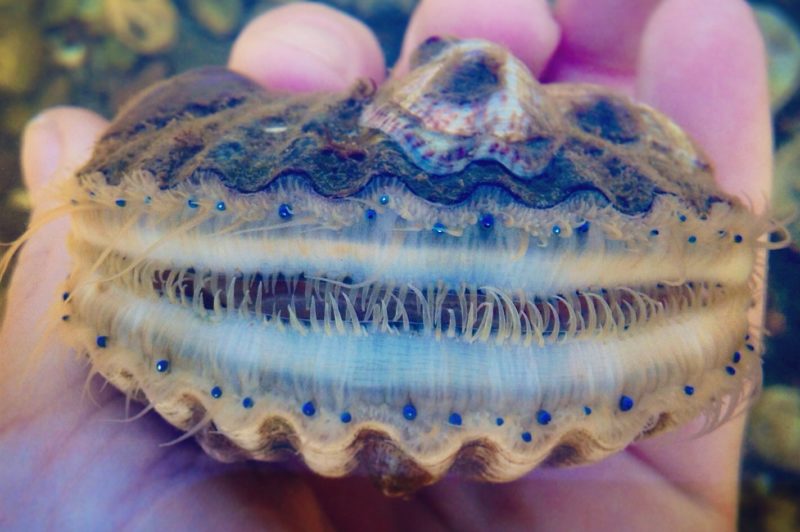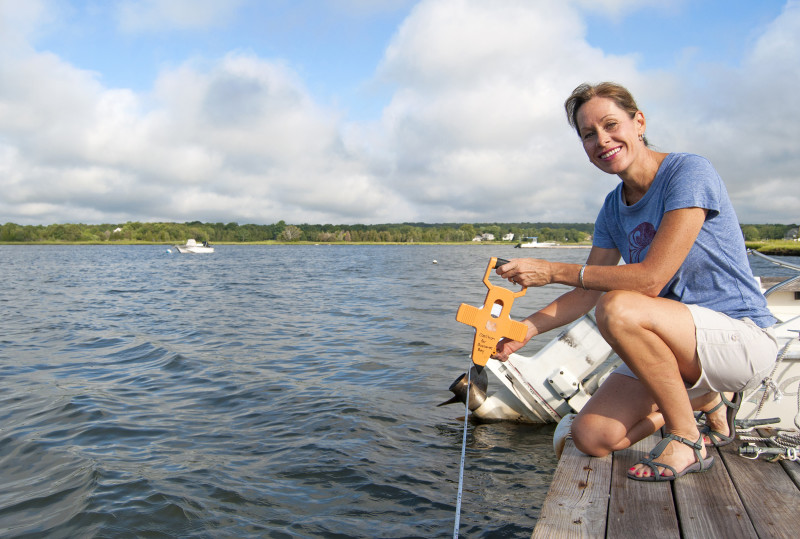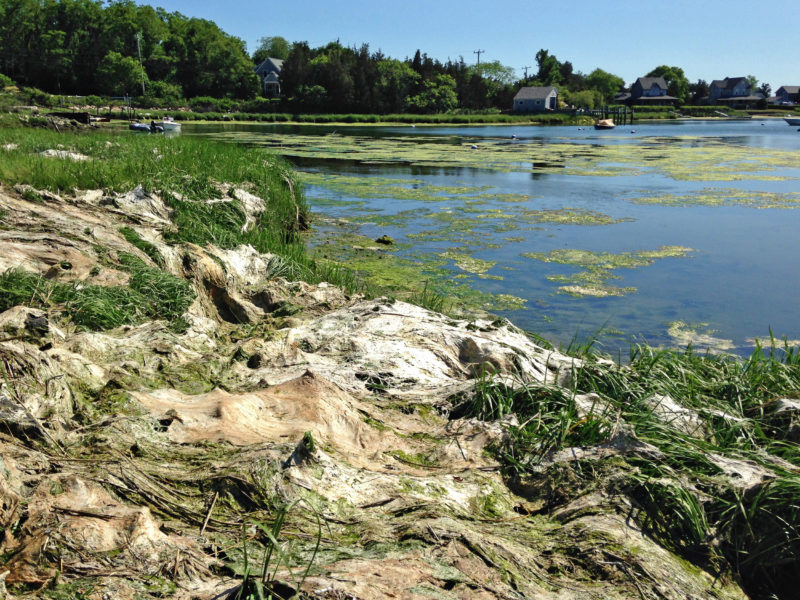Baywatchers data highlights path to protecting shellfish from acidification
Using water quality data collected by the Coalition, scientists at the Woods Hole Oceanographic Institution (WHOI) have uncovered another reason to reduce nitrogen pollution in Buzzards Bay: nitrogen makes coastal waters more acidic, posing a threat to the region’s shellfish industry as well as important Bay habitats.
What’s more, it’s a problem that is getting worse due to climate change.

Ocean acidification may cause shellfish, like this bay scallop from Mattapoisett Harbor, to grow more slowly or have brittle shells. In extreme cases, acidic waters can start to dissolve existing shells.
“Shellfish are a critical part of the Bay’s ecosystem that help to filter our water,” said Dr. Rachel Jakuba, Coalition science director and a co-author on the research. “In this study, we looked at how nitrogen pollution in Buzzards Bay could make it harder for our oysters, quahogs, scallops, and mussels to grow their protective shells.”
The results underscore the importance of reducing major nitrogen pollution sources in the Bay’s watershed, especially septic systems.
These findings come from a collaboration with Jennie Rheuban and Dr. Daniel McCorkle of WHOI, and Dr. Scott Doney of the University of Virginia. The research was funded by the John D. and Catherine T. MacArthur Foundation.
The new research rests on the nearly 30-year dataset of Bay nitrogen levels created by the Coalition’s Baywatchers program, which collects samples every summer to test the health of the Bay’s major waterways.
Nitrogen pollution is already one of the most pervasive problems endangering Bay health. The new research used Baywatchers data to investigate how nitrogen also plays a role in a process known as ocean acidification, a growing global problem. As carbon dioxide from burning fossil fuels increases in the atmosphere, more and more of it dissolves into seawater, causing a chemical reaction that makes the water more acidic.
Yet carbon dioxide doesn’t just enter coastal waters from the atmosphere. High levels of nitrogen feed the blooms of green, mucky algae that we see in some waterways during the warmer months. As this algae dies and decomposes, it too produces carbon dioxide and causes acidification.
Acidic waters contain less carbonate, an essential ingredient ocean creatures use to create hard shells. In acidic waters shellfish may grow more slowly, or have brittle shells that break easily. In extreme cases, existing shells could start to dissolve.

Volunteer Baywatchers take water samples every summer that help the Coalition track Buzzards Bay’s health over time.
In places with poor water quality, like inner West Falmouth Harbor, the research showed that nitrogen pollution is responsible for as much as 50 percent of the acidification.
“This means that many of our coastal estuaries that are impaired by nitrogen are also likely acidified,” said WHOI research associate Jennie Rheuban, who led the study.
The research team worked on this project over the course of two years, sampling water at stations in Quissett Harbor, West Falmouth Harbor, the Wareham River, New Bedford Harbor, and the east branch of the Westport River. The team sampled both the outer part of the waterway – where water is well-flushed, and therefore holds less pollution – and the inner part of the waterway, where any nitrogen pollution would likely be more concentrated. They compared this data to a station at the center of Buzzards Bay, as a relatively low-pollution reference point.
The research showed that the inner portions of each waterway were more acidic than the more well-flushed outer parts of the waterways. It also was able to disentangle the impacts of nitrogen pollution from other causes of acidification. For example, fresh water flowing from rivers into estuaries is slightly acidic, and can also have an effect on the acidity of coastal waters.
These findings provide yet another reason why reducing nitrogen pollution is one of the best ways to ensure a clean and healthy Buzzards Bay – and why it’s a major focus of the Coalition’s work. Nitrogen pollution already makes life tougher for Bay marine life by clouding waters and killing eelgrass beds, where shellfish like scallops thrive.
The best way to prevent these devastating effects is to switch to nitrogen-reducing septic systems, which serve as the biggest source of nitrogen to Buzzards Bay. Conventional septic systems adequately remove most types of bacteria, but remove very little nitrogen before the wastewater travels through the ground and into the Bay.
This research also showed that preventing the damaging impacts of ocean acidification to coastal Buzzards Bay waters is within reach. If local towns reduced nitrogen pollution to state-mandated limits (known as TMDLs), it would allow acidity levels to return to normal in impaired water bodies.

When water is polluted with nitrogen, it becomes cloudy and murky with algae, and fish, shellfish, and eelgrass begin to disappear.
“A global scale problem like ocean acidification can seem daunting to tackle,” said Jakuba. “But reducing nitrogen pollution is something we can do locally to help protect shellfish in our Bay.”
Previous scientific research using Baywatchers data indicates that reducing nitrogen pollution will also encourage more people to take advantage of healthy shellfish populations through recreational shellfishing. Baywatchers data that documented worsening water quality over time was associated with fewer recreational shellfish permit sales.
Rheuben described the Baywatchers data as critical to the success of their project, both in the historical context it provided, and the role it has played in analyzing how nitrogen impacts our local waters.
She added: “Long-term monitoring data sets such as the Baywatchers’ are uncommon, and valuable to exploring how water quality in our coastal ecosystems are responding to an era of incredibly rapid regional and global change.”